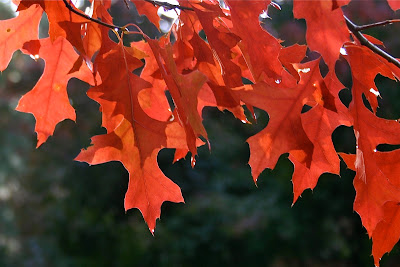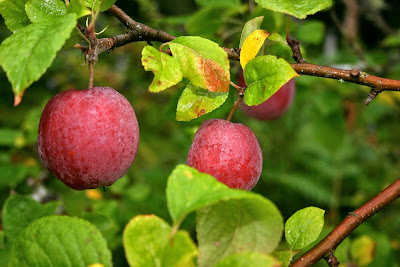 |
| Our vine maple, one of nature's weed trees. |
I love this season of colorful vine maples and ripening huckleberries in our half-wild back yard. We live in a forest setting so you might say the view never changes – just trees and sky.
But what's changing constantly for Sue and me are the birds and wildlife that come and go all day.
We look up and see deer grazing or a coyote slinking across the yard. We check a certain tree overlooking our orchard and find Bubba, our owl friend, sleeping off a hard night. And we dodge fir cones the squirrels rain down on us as they strip the trees to stockpile reserves for the winter.
 |
| A Cedar Waxwing brings salal berries to its young in our yard. |
Moving here from the city in the 1980s my intentions for the yard were quite different. My dream was to eradicate the native brush and rotting snags and replace them with a weedless, sterile lawn and the kinds of flowers I’d admired for years in city yards.
With power tools and poisons, I would conquer every square inch of our yard, rid our view of huckleberries, pave our gravel road and plant a rose garden.
 |
| This season's huckleberries are plumping up right now. |
I asked a local nursery about chemicals to kill weeds and moss, grow grass, and stamp out fungus and Black Spot. To my surprise, they answered as non-judgmentally as they could that they didn’t carry poisons or encourage their use.
It took me a long time to get that it isn't a step forward to conquer and replace nature -- just the opposite. Huckleberries and salal are a magnet for the birds and animals that now bring beauty and mystery to our lives every day. These hardy bushes provide shelter to ground-nesting birds, rabbits and voles, which attract other wildlife to our yard to hunt.
 |
| A Red-breasted Sapsucker eats our huckleberries. |
Some might say an old, rotting snag is ugly, but it’s beautiful if you love the sensational Pileated Woodpeckers that come to jackhammer it.
Last summer we watched elegant Cedar Waxwings feed their gangly newborns in a tree by our deck. And we delighted when Northern Flickers brought their vulnerable young to peck ants from our crumby lawn, which is riddled with dandelions the rabbits eat. Every winter, our berry-laden bushes attract colorful visitors such as Red-breasted Sapsuckers to brighten the view outside our windows.
Like many other people, we put out a hummingbird feeder each spring to welcome the tiny Rufous Hummingbirds that migrate thousands of miles to return here -- specific individuals often showing up in the same yards where they were banded in past years! But we don't kid ourselves. We know they aren't here for a few cups of sugar water in a plastic dish. They come in droves for the blossoming salmonberry bushes that grow wild in the woods.
 |
| This Varied Thrush had a winter feast on our crabapples. |
The wild creatures are a huge part of our quality of life. It's one of the reasons Sue and I support Whidbey Camano Land Trust in their work to preserve farms, forests and other healthy habitat.
I've gradually learned we don’t have to control everything. Better to leave nature alone as much as reasonably possible so it can create something beautiful. If we interfere too much, we’ll just screw it up and make a poorly-functioning, problematic mess.
Sue and I were guests recently at the waterfront home of a gracious couple who live on a high bluff overlooking Puget Sound. They watch boats all day. They are enjoying their golden years dining on crabs and salmon they catch from their own boat in front of their own home. It’s the Puget Sound dream!
What could be healthier than fresh salmon? Well, just not too much, too often, because the flesh might be somewhat toxic. The experts say it's probably safe in moderation, but be careful if you're pregnant or nursing. That's the flip side of the Puget Sound dream.
 |
| This handsome young coyote had a sweet tooth for Gravensteins. |
Our friends' view is breathtaking. But as is typical of high-bluff properties, they have a long pipe called a tight-line that carries roof runoff including any moss-killing products down the bluff to the beach, where forage fish lay their eggs. Salmon feed voraciously on those forage fish, to the extent that they hatch and survive.
This couple’s pride is their perfect front yard, a fairyland of manicured beds, interconnecting lawns, vegetable plots and winding paths. They've cleared the trees and brush and scraped away centuries of ground cover.
 |
| "Bubba," the Great-horned Owl, is our rodent police. |
Now to their dismay, their new lawn is sprouting buttercups – even after they applied weed-n-feed. Their vision is to gaze at a deep, lush carpet of green, so they asked us about products to kill the broadleafs.
“It depends on your values and vision,” I blurted, then instantly regretted the edge in my voice. The last thing I wanted to do was attack the wonderland our hosts had worked so hard to create.
What I wanted to explain is that beauty means different things to different people. I’ve come to believe the most beautiful and joyful thing in my world is to live in a place that is healthy for wildlife and humans. Buttercups aren’t so bad. Weeds grow where we disturb the soil, but not where nature runs the show.
 |
| Even this guy makes us smile. |
Plants need excessive watering when we introduce the wrong ones. Leave nature alone and it will choose the right, drought-tolerant plants. Grass is a good ground cover for septic drain-fields but not much else when you live in a climate of dry summers and moss-promoting winters.
Of course most people don't have the space to live quite as wild as we do. But even in a built-up neighborhood -- in fact especially there -- why not steer away from chemicals? Keep some natural ground cover and pursue a different vision. Offer the wildlife a sliver of wild habitat, safe food and clean water. If we all do that, our earth and marine waters will be healthier.
 |
| Blacktail deer bring quiet grace to our forest setting. |
To me, a few yellow flowers in a lawn aren’t ugly; they’re beautiful. They make a statement about what's really important versus just cosmetic.
They are a sign the birds can bring their young to eat from that lawn without getting poisoned, and that we aren’t poisoning the ground from which we draw the previously-used water we drink every day of our lives.
Everything is connected. Beauty is more than skin deep -- much, much more.




























